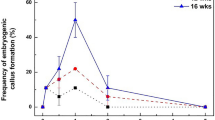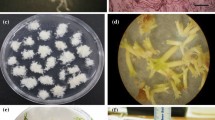Abstract
Somatic embryos (SE) of alfalfa, celery, and cauliflower were encapsulated as single–embryo beads approximately four millimeters in diameter to produce individual somatic (artificial) seeds. The SE were mixed in sodium alginate and dropped into a solution of calcium chloride to form calcium alginate beads via an ion exchange reaction. For our two best somatic embryogenesis systems, alfalfa and celery, in vitro germination frequencies with production of seedling–quality plants were routinely 30% and 65%, respectively. In addition, encapsulated alfalfa and celery SE developed into plants in sand trays or in transplant plugs at frequencies of 7% and 10%. The production of seedling–quality plants from individual somatic seeds, as first reported here, has potential as a novel, universal delivery system.
This is a preview of subscription content, access via your institution
Access options
Subscribe to this journal
Receive 12 print issues and online access
$209.00 per year
only $17.42 per issue
Buy this article
- Purchase on Springer Link
- Instant access to full article PDF
Prices may be subject to local taxes which are calculated during checkout
Similar content being viewed by others
References
Murashige, T. 1978. The impact of plant tissue culture on agriculture, p. 15–26. In: Frontiers of Plant Tissue Culture 1978. T. Thorpe (ed.) The International Association for Plant Tissue Culture, University of Calgary, Alberta, Canada.
Durzan, D. 1980. Progress and promise in forest genetics; p. 31–60. Proceed. 50th Anniversary Conference “Paper Science and Technology—The Cutting Edge,” The Institute of Paper Chemistry, Appleton, Wisc.
Murashige, T. 1980. Plant growth substances in commercial uses of tissue culture, p. 426–434. In: Plant Growth Substances 1979. F. Skoog (ed.) Springer Verlag, New York.
Anonymous, 1980. Impacts of Applied Genetics (U.S. Government Printing Office, Washington, D.C. ♯81-60046).
Evans, D. and Sharp, W. 1982. Application of tissue culture technology in the agricultural industry, p. 209–231. In: Application of Plant Cell and Tissue Culture to Agriculture and Industry. D. Tomes, et al. (eds.) University of Guelph Press, Guelph, Ontario, Canada.
Krikorian, A. 1982. Cloning higher plants from asceptically cultured tissues and cells. Bot. Rev. 57:182–185.
Redenbaugh, K., Nichol, J. Kossler, M.E. and Paasch B. 1984. Encapsulation of somatic embryos for artificial seed production. In Vitro 20:256–257 (Abst.).
Van Brunt, J. 1985. Non-recombinant approaches to plant breeding. Bio/Technology 3:975–980.
Kitto, S. and Janick, J. 1980. Water soluble resins as artificial seed coats. Hort. Sci. 15:439 (Abst.).
Kitto, S. and Janick, J. 1981. Testing artificial seed coats for asexual embryos. Hort. Sci. 16:452 (Abst.).
Kitto, S. and Janick, J. 1982. Polyox as an artificial seed coat for asexual embryos. Hort. Sci. 17:448 (Abst.).
Kitto, S. and Janick, J. 1983. ABA and chilling increase survival of asexual carrot embryos encapsulated with artificial seed coats. Hort. Sci. 18:104 (Abst.).
Kitto, S. and Janick, J. 1985. Production of synthetic seeds by encapsulating asexual embryos of carrot. J. Amer. Soc. Hort. Sci. 110:277–282.
Kitto, S. and Janick, J. 1985. Hardening treatments increase survival of synthetically-coated asexual embryos of carrot. J. Amer. Soc. Hort. Sci. 110:283–286.
Crouch, M. 1980. Storage Proteins as Embryo-Specific Developmental Markers in Zygotic, Microsporic and Somatic Embryos of Brassica napus L. University Microfilms, University of Michigan, Ann Arbor.
Stuart, D., Nelsen, J., Strickland, S., and Nichol, J. 1985. Factors affecting developmental processes in alfalfa cell cultures, p. 59–73. In: Tissue Culture in Forestry and Agriculture. R. Henke, et al. (eds.) Plenum Press, New York.
Walker, K. and Sato, S. 1981. Morphogenesis in callus tissue of Medicago sativa: the role of ammonium ion in somatic embryogenesis. Plant Cell Tiss. Org. Cult. 1:109–121.
Walker, K., Wendeln, M., and Jaworski, E. 1979. Organogenesis in callus tissue of Medicago sativa. Plant Sci. Lett. 16:23–30.
Stuart, D. and Strickland, S. 1984. Somatic embryogenesis from cell cultures of Medicago sativa. Plant Sci. Lett. 34:165–174.
Schenk, R. and Hildebrandt, A. 1972. Medium and techniques for induction and growth of monocotyledons and dicotyledons cell cultures. Can. J. Bot. 50:199–204.
Sokal, R. and Rohlf. F. 1969. Biometry, p. 549–620. W. H. Freeman and Co., San Francisco.
Author information
Authors and Affiliations
Rights and permissions
About this article
Cite this article
Redenbaugh, K., Paasch, B., Nichol, J. et al. Somatic Seeds: Encapsulation of Asexual Plant Embryos. Nat Biotechnol 4, 797–801 (1986). https://doi.org/10.1038/nbt0986-797
Received:
Accepted:
Issue Date:
DOI: https://doi.org/10.1038/nbt0986-797
This article is cited by
-
Alginate encapsulation of micro-cuttings in endangered Satureja khuzistanica species: a promising method for obtaining genetically stable plants with high rosmarinic acid content
Plant Cell, Tissue and Organ Culture (PCTOC) (2022)
-
Cryopreservation of rhizome buds of Asparagus officinalis L. (cv. Morado de Huétor) and evaluation of their genetic stability
Plant Cell, Tissue and Organ Culture (PCTOC) (2018)
-
Optimization of the conditions for production of synthetic seeds by encapsulation of axillary buds derived from minituber sprouts in potato (Solanum tuberosum)
Plant Cell, Tissue and Organ Culture (PCTOC) (2016)
-
Production of chrysanthemum synthetic seeds under non-aseptic conditions for direct transfer to commercial greenhouses
Plant Cell, Tissue and Organ Culture (PCTOC) (2015)
-
Embryogenesis and synthetic seed production in Mondia whitei
Plant Cell, Tissue and Organ Culture (PCTOC) (2015)



